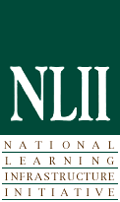

Deeper Learning
Teaching Practices
Design Implications
Learning Activities
Mapping
the Learning Space:
Technology Uses in Teaching and Learning
24/7. Anytime, anywhere. Online, distant, extended education. Technology has changed the way a generation thinks about learning. It has created classrooms without walls and brought libraries into our living rooms. Although technology enables transformation, it does not dictate improvement or guarantee significant change. It is not the tool itself that creates meaningful learning, but the desired outcome to which the tool is applied.
Simple applications of use
that have produced a literature of best practice is in the development
of online community.
Email allows both teacher and student a venue for
private, non-invasive dialog. The ability to email an instructor gives
students a non-threatening venue for approaching their instructor and gives
instructors a means of controlled response and an alternative for reaching
out. Best practices dictate that the instructor set very clear expectations
on types of email accepted and expected response times.
Access to communications between fellow students can also significantly change the course experience. Students feel greater ownership and engagement when their work, writing, and views are made public - in course chat sites, discussion boards and web pages. The larger the possible audience, the more engaged a student might feel about posting their knowledge and observations. Introverted students have less difficulty posting a response or question than in speaking up in class while reflective students can linger over their thoughts before devising a response. Night owls bring energy and excitement to the course dialog at 3am. Technology makes this extended dialog possible.
More complex is the use of
 multimedia in the classroom.
Faculty may not feel comfortable with the many possibilities for things to
go wrong, settings to have changed, equipment to function as expected. A
good infrastructure and support system is often listed as crucial in the
successful use of audio,
video, simulation,
and technology-based presentation in the
classroom. Computers for all students adds another layer of complexity,
demanding consistent maintenance and refreshing of machines, as well as a
change of pedagogy. The 1:1 laptop initiative now seen across higher education will fail if we ask students to bring laptops to school and then provide scant resources to recharge batteries, spotty campus wireless and exclusion of faculty in the conversation on use.
multimedia in the classroom.
Faculty may not feel comfortable with the many possibilities for things to
go wrong, settings to have changed, equipment to function as expected. A
good infrastructure and support system is often listed as crucial in the
successful use of audio,
video, simulation,
and technology-based presentation in the
classroom. Computers for all students adds another layer of complexity,
demanding consistent maintenance and refreshing of machines, as well as a
change of pedagogy. The 1:1 laptop initiative now seen across higher education will fail if we ask students to bring laptops to school and then provide scant resources to recharge batteries, spotty campus wireless and exclusion of faculty in the conversation on use.
Students become independent learners quickly with computer in hand and the faculty member must have a new skill set in
place to deal with surfing, email, printing and chat sessions running
during periods when the students need to collectively focus on the course
content. Computer instruction often relies on students being able to
follow along on their own machine initially, demanding a linear,
methodical presentation "hear, see, do" delivery from the instructor.
Faculty may also admire, but not feel personally skilled at, creation of online learning materials. The work of David Jonassen in using very standard software to facilitate higher-order thinking with "MindTools" is an excellent starting place for effective use of simple technology in learner-centered practices.
More complicated learning objects can be found and shared at the MERLOT referatory, where online learning materials are collected and catalogued, along with annotations of peer reviews and related assignments. If the Web is now seen as a container for millions of learning objects, the process of "Webquests" is an easily structured way of making that information meaningful and thoughtful retrieval by the student a 'best practice' in learner-centered technology access.
Many technology tools and access to their best practices can be found in collective tool set and navigation framework of course management systems. Discussion boards, chat sites, group email as well as easy access to course documents, announcements and assignments make standard tools available from one CMS window. One of the most well-received tools, by students and instructors, is the assessment technology bundled within good CMS systems. Immediate feedback, allowing multiple attempts, guided response to supplemental readings for missed questions and student ability to track their grades have made significant difference in approaches to meaningful assessment due to these tools.
Technology has been the
largest factor in the rapid change recently seen in higher education
practices. Whether in the classroom, in faculty-student interaction, in
online or hybrid classes, the "classroom" will continue to be redefined as
broader bandwidth brings synchronous protocols and possibilities into the
reach of faculty and students. Anytime/anywhere will become
everywhere/every option/every learner. Success will depend on a strong
infrastructure, strong faculty support, innovative faculty development,
rethinking reward systems and excellent technology support services.
What tools should we use to get there? Perhaps there is no right answer, but each year a very thoughtful group of researchers ask this question and collectively frame a considered response. Visit the New Media Consortium's Horizon Report page for a look at what's here, what's coming and what's a glimmer in the distance!